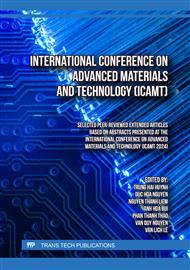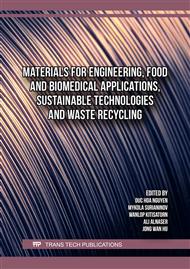[1]
Cavaliere, Pasquale. Direct Reduced Iron: Most Efficient Technologies for Greenhouse Emissions Abatement In Clean Ironmaking and Steelmaking Processes: Efficient Technologies for Greenhouse Emissions Abatement, 419-484. Cham: Springer International Publishing, 2019.
DOI: 10.1007/978-3-030-21209-4_8
Google Scholar
[2]
Kasai, Akito, Hitoshi Toyota, Kentaro Nozawa, and Shuji Kitayama, Reduction of Reducing Agent Rate in Blast Furnace Operation by Carbon Composite Iron Ore Hot Briquette, ISIJ International, vol. 51, no. 8 (2011) 1333-1335.
DOI: 10.2355/isijinternational.51.1333
Google Scholar
[3]
Gupta, R.C., Theory and laboratory experiments in ferrous metallurgy, New Delhi-110001: PHI Learning Privated Limited, 2010.
Google Scholar
[4]
Chatterjee, Amit, Sponge Iron Production by Direct Reduction of Iron Oxide, 2nd ed: PHI Learning, 2012.
Google Scholar
[5]
Geerdes, M., R. Chaigneau, I. Kurunov, O. Lingiardi, and J. Ricketts, Modern Blast Furnace Ironmaking: An Introduction, 3rd ed: PHI Learning Private Limited, 2015.
DOI: 10.3233/stal9781643681238
Google Scholar
[6]
Ghosh, Ahindra, and Amit Chatterjee, Ironmaking and steelmaking : theory and practice, New Delhi-110001: : PHI Learning Privated Limited, 2008.
Google Scholar
[7]
Medeiros, Giulio Antunes de, Leonardo Martins da Silva, Márcio Teodoro Fernandes, Daniel Gomes de Souza dos Santos, and José Adilson de Castro, Analysis of the carbothermic reduction of iron ore-coke composite mixtures by microwave heating, Mater. Res., vol. 24, no. 6 (2021).
DOI: 10.1590/1980-5373-mr-2021-0284
Google Scholar
[8]
Agrawal, Shrey, and Nikhil Dhawan, Carbothermic microwave processing for the enrichment of iron ore fines, J. Sustain. Met., vol. 6, no. 2 (2020) 355-366.
DOI: 10.1007/s40831-020-00279-2
Google Scholar
[9]
Kaushal, Sarbjeet, Sandeep Bansal, Chander Prakash, Bhupinder Singh, and Dheeraj Gupta, Green manufacturing and materials processing methods, Boca Raton: CRC Press, 2024.
Google Scholar
[10]
Phung Kien Cuong, Ngo Quoc Dung, Do Thi Ngoc Anh, Ngo Sy Hieu, Ngo Duc Tuyen, Nguyen Quang Tung, Chu Thi Minh Thu, Lai Vinh Khoi, Do Nguyen Quang Chien, Nguyen Thi Hoang Oanh, and Nguyen Hoang Viet, Sự thay đổi cấu trúc của quặng viên composit manhêtit trộn than trong quá trình hoàn nguyên trạng thái rắn trong lò vi sóng, Journal of Science and Technology of Metals, vol. 98 (2021) 2-7 (in Vietnamese).
DOI: 10.52923/vmfs.jstm.102021.98.01
Google Scholar
[11]
An, Yaxiong, Peng Gao, Jianwen Yu, and Yuexin Han, Reduction behavior of hematite ore with different particle sizes in suspension roaster, Advanced Powder Technology, vol. 33, no. 10 (2022) 103717.
DOI: 10.1016/j.apt.2022.103717
Google Scholar
[12]
Wong, Wai, and Manoj Gupta, Microwave and Metals, 2007.
Google Scholar
[13]
Rajavaram, Ramaraghavulu, Jaehong Lee, Joon Seok Oh, Han Kim, and Joonho Lee, Microwave heating characteristics of magnetite ore, Metals and Materials International, vol. 22 (2016) 1116-1120.
DOI: 10.1007/s12540-016-6045-2
Google Scholar
[14]
Walkiewicz, J. W., G. Kazonich, and S. L. McGill, Microwave heating characteristics of selected minerals and compounds, Minerals & Metallurgical Processing, vol. 5, no. 1 (1988) 39-42.
DOI: 10.1007/bf03449501
Google Scholar
[15]
Weisenberger, Matthew C., Jordan Burgess, Harold H. Schobert, and James C. Hower, Thermal properties of Pennsylvania anthracite, Fuel, vol. 266 (2020) 117101.
DOI: 10.1016/j.fuel.2020.117101
Google Scholar
[16]
Chatterjee, I., and M. Misra, Dielectric Properties of Various Ranks of Coal, Journal of Microwave Power and Electromagnetic Energy, vol. 25, no. 4 (2016) 224-229.
DOI: 10.1080/08327823.1990.11688130
Google Scholar
[17]
Cheng, Xiang-li, Kai Zhao, Yuan-hong Qi, Xue-feng Shi, and Chang-liang Zhen, Direct Reduction Experiment on Iron-Bearing Waste Slag, Journal of Iron and Steel Research, International, vol. 20, no. 3 (2013) 24-35.
DOI: 10.1016/s1006-706x(13)60064-3
Google Scholar
[18]
Yu, Dawei, Mingqian Zhu, Torstein A. Utigard, and Mansoor Barati, TG/DTA study on the carbon monoxide and graphite thermal reduction of a high-grade iron nickel oxide residue with the presence of siliceous gangue, Thermochimica Acta, vol. 575 (2014) 1-11.
DOI: 10.1016/j.tca.2013.10.015
Google Scholar



